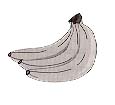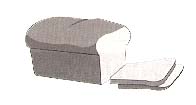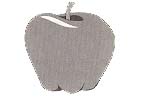

Measuring Up Your Nutritional Program

When your child care centre's program seems to be running smoothly, there is often little incentive to find the time in your hectic day to schedule in regular reviews. But, perhaps the task would be less daunting if you review one component of the program at a time. "Measuring up" your nutritional program does not have to be a time-consuming task. Your review may confirm that everything is on the mark or may identify practices that need to be revised.
The following chart provides guidelines that you can use to evaluate your nutritional program for children two years of age and older.
 Menus are varied,
interesting and creative
(e.g., variety of colours,
shapes, textures and
tastes).
Menus are varied,
interesting and creative
(e.g., variety of colours,
shapes, textures and
tastes).
Menus are planned and served with children in mind (eg., some finger foods, child-sized servings, and age-appropriate dishes and utensils). Preschool and school-age children have opportunities to serve themselves.
Menus are posted in an obvious place for parents to read.
The posted menu always corresponds with what is actually served.
 Snacks are low in sugar
and are nutritionally
acceptable.
Snacks are low in sugar
and are nutritionally
acceptable.
Desserts, if provided, are a nutritional part of the meal (e.g., fruits, yogurt and homemade puddings).
Real, unsweetened fruit juices are provided -- not "fruit drinks" with added sugar/sweetener.
Foods that have been through a number of food processes and/or have several additives are not served (e.g., instant potatoes, pudding mixes and processed meats).
There is enough food to satisfy children's hunger.
Children's rights are respected (e.g., not forced to eat foods they don't like and not teased for being unskilled with spoons or forks).
Individual food likes and dislikes are acknowledged, promoting the child's self-esteem.
Food beverages and desserts are not used as bribes or punishments.
Children are not forced into conforming to rigid rules or expected to have "perfect" table manners.
Children are guided (e.g., adult modeling) to observe certain behaviours while eating, developing a sense of self-respect and respect for others.
Parents are encouraged to: comment/ask nutritional questions with regard to the centre's and their child's nutrition, contribute nutritional foods/snacks for special occasions, and invited to participate provide favourite/cultural recipes.
Foods served for celebrations and holidays are nutritious and fun.
Children are encouraged to share food experiences from their own cultural and regional backgrounds and are introduced to foods from around the world as part of the regular menu.
Children are encouraged to develop their five senses in enjoying a variety of foods.
Caregivers utilize opportunities to build language skills through food routines and nutritional learning experiences (e.g., using the correct terms for food, equipment, cooking processes and discussion about foods).
Children regularly have the opportunity to participate in food preparation. In addition to viewing meal and snack preparation as important aspects of everyday life, they also build their cooking skills and have opportunities for building cooperation.
Cognitive opportunities are made available and facilitated through foods, for example: seeing similarities and differences (classification, categorization) temporal relations sense of quantity and measurement problem solving (e.g., what will happen if ...) matching, one-to-one correspondence learning about growing plants, etc.
Used with permission from Barb Pimento, professor, Early Childhood Education Program, George
Brown College, Toronto, Ontario, 1994.
Interaction (Summer, 1994 p.15)
Bates, D.R. (1987). Kids Can Cook: Vegetarian Recipes Kitchen Tested by Kids for Kids. The Book
Publishing Company: Summertown, Tennessee.
Berman, D. and Fromer, J. (1991). Meals Without Squeals: Child Care Feeding Guide and Cookbook.
Bull Publishing Co.: Palo Alto.
Cestnik, J. and Cestnik, L. (1990). The Caboodle Cookbook: Quality Cooking For, With or By Kids.
Caboodle & Company: Toronto.
Faggella, K. (1991). Through the Seasons: Hands-On Cooking. First Teachers Press: Bridgeport,
CT, (Pre-K to Grade Two).
Harms, T. (1981). Learning from Cooking Experiences: A Teacher's Guide to Accompany Cook and
Learn. Addison-Wesley: Don Mills.
Lambert-Lagacé, L. (1992). Feeding Your Baby in the Ninties: From Conception to Age Two.
Stoddart Publishing Co.: Toronto.
Lambert-Lagacé, L. (1993). Feeding Your Preschooler: Tasty Nutrition for Kids Two to Six. Stoddart
Publishing Co.: Toronto.
Mendelson, S. and Mendelson, R. (1994). Food to Grow On. Harper Collins Publishers Ltd.:
Toronto, (based on the new Canada's Food Guide to Healthy Eating).
Pollution Probe (1994). Additive Alert. Contact Pollution Probe, 12 Madison Avenue, Toronto,
Ontario, M5R 2S1. Tel: (416) 497-8168.
Veitch, B. and Harms, T. (1981). Cook and Learn: A Child's Cook Book. Addison-Wesley: Don
Mills, (Nutritious Foods from Various Cultures, Pictorial Single Portion Recipes).
Warren, J. (1992). Super Snacks: Seasonal Sugarless Snacks Recipes for Young Children. Warren
Publishing House, Inc.: Everett, Washington.
Williamson, S. and Williamson, Z. (1993). Kids Cook: Fabulous Food for the Whole Family.
Williamson Publishing Co.: Charlotte, Vermont.
Developed by Deborah Kernested, RN, HIV/AIDS child care project manager, Canadian Child
Care Federation, and child care project coordinator of "Well-Beings," Canadian Paediatric
Society.
Canadian Child Care Federation
For further reading
 |  |  |